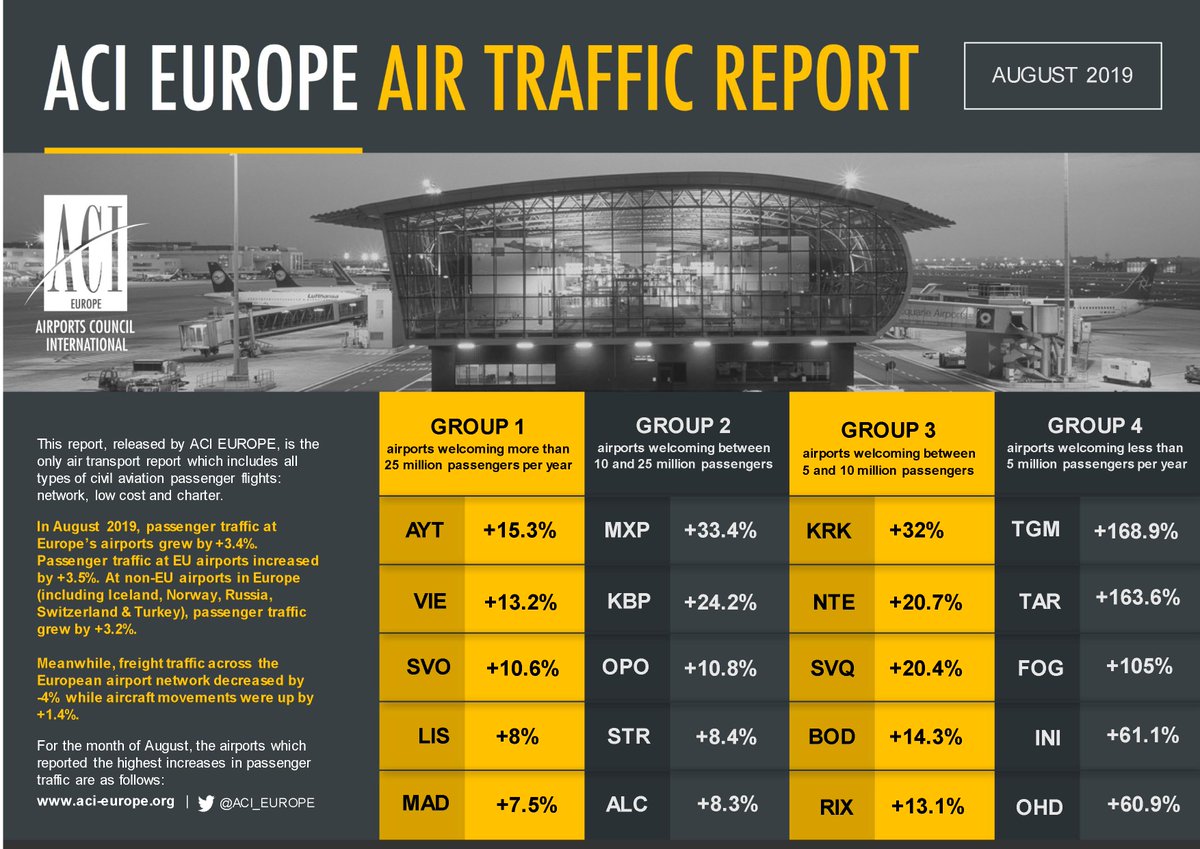August passenger traffic up +3.4% freight down 4%
10 October 2019Brussels - European airport trade association, ACI EUROPE today releases its traffic report for August 2019, during which average passenger traffic in geographical Europe climbed by +3.4%. While this is an improvement compared to the previous month (+2.2% in July), this remains below the performance of August 2018 (+5.1%) – reflecting generally less favourable trading conditions for Europe’s airports.
In this context, freight traffic decreased by -4% in August - remaining the most exposed to on-going trade wars and a weakening global economy. Meanwhile aircraft movements only expanded by +1.4%, reflecting airlines limiting capacity expansion & network developments, the continued grounding of the 737MAX and the impact of consolidation.
EU & NON-EU MARKETS EVEN OUT
EU airports posted an average increase of +3.5% in passenger traffic in August – mostly driven by international traffic (+3.9%) rather than domestic traffic (+1.3%).
The Austrian and Latvian markets achieved double digit growth, while Italy & Malta (+8.1%), Croatia (+7.8%), Luxembourg (+7.4%), Finland (+7.3%) and Portugal (+7.1%) significantly outperformed the EU average. Conversely, airports in Bulgaria (-5.4%), Sweden (-3.3%), Cyprus (+0.7%), the Netherlands (+0.2%), Germany (+1.2%) and the UK (+1.6%) came at the other end of the spectrum.
Several capital & larger EU airports achieved well above average results. Milan Malpensa’s bumper growth (+33.4%) was fueled by the traffic transferred from Milan Linate, which remains closed until 27 October for runway maintenance. Dynamic passenger growth was also booked by Vienna (+13.2%), Riga (+13.1%), Lisbon (+8%), London Luton (+7.9%), Madrid (+7.5%), Luxembourg (+7.4%), Helsinki (+6.7%) and Prague (+6.5%).
Meanwhile, passenger traffic expanded by +3.2% at non-EU airports – entirely driven by international traffic (+8%) as domestic traffic decreased sharply (-5%).
Airports in Ukraine (+25.1%), North Macedonia (+17.8%), Albania (+13%), Bosnia and Herzegovina (+12.1%) and Serbia (+12%) led the non-EU markets. But as a result of the continued fallout triggered by the bankruptcy of the ultra-low cost carrier WOW Air, Iceland took the hardest hit in the entire region (-29.4%), while Georgia (-15.3%) also suffered severe setbacks and Norway was nearly flat (-0.6%). Russian airports saw passenger traffic growing by +4.9% and those in Turkey by +2.9% - recovering from its traffic slump in July (-3.5%).
Accordingly, amongst the capital & larger non-EU airports, Kyiv Boryspil (+24.2%), Antalya (+15.3%), Tirana (+13%), Sarajevo (+12.2%), Skopje (+11.1%), Moscow Sheremetyevo (+10.6%) achieved the highest growth.
MAJORS & SMALLER REGIONAL AIRPORTS UNDERPERFORMING
Passenger growth at the Majors (top 5 European airports) in August was
fairly limited at +1.3%. Paris-CDG kept leading the league (+4.3%),
followed by Frankfurt (+1.7%). Istanbul-IST (+0.9%) was nearly flat, as
well as capacity constrained London-Heathrow (+0.1%) and Amsterdam-
Schiphol (-0.5%).
Smaller regional airports (less than 5 million passengers/annum) also
underperformed at +0.3% reflecting the fragility of their markets when
trading conditions deteriorate. 53% of them were losing traffic during
August - compared to 39% for the wider European average.
Apart from Nis (+61.1%), Ohrid (+60.9%), Turku (+60.3%), Kharkhiv
(+38%), Zadar (+29.6%) and Memmingerberg (+25.8%), the best
performance amongst regional airports came from larger ones: Krakow
(+32%), Nantes (+20.7%), Sevilla (+20.4%), Bordeaux (+14.3%), Bari
(+11.5%) and Porto (+10.8%).
NON-EU MARKET IN THE LEAD ON FREIGHT
Freight traffic at EU airports dropped by -5.9% in August. Meanwhile,
non-EU airports fared considerably better, averaging out at +6.2%.
Amongst the top 10 European hubs for cargo operations, only Madrid-
Barajas (+7.2%) reported expansion.
During the month of August, airports welcoming more than 25 million
passengers per year (Group 1), airports welcoming between 10 and 25
million passengers (Group 2), airports welcoming between 5 and 10 million
passengers (Group 3) and airports welcoming less than 5 million
passengers per year (Group 4) reported an average adjustment +3.2%,
+5%, +3.2% and +1.2%.
The airports that reported the highest increases in passenger traffic during
August 2019 (compared with August 2018) are as follows:
GROUP 1: Antalya (+15.3%), Vienna (+13.2%), Moscow SVO (+10.6%), Lisbon (+8%) and Madrid (+7.5%)
GROUP 2: Milan MXP (+33.4%), Kyiv KBP (+24.2%), Porto (+10.8%), Stuttgart (+8.4%) and Alicante (+8.3%)
GROUP 3: Krakow (+32%), Nantes (+20.7%), Sevilla (+20.4%), Bordeaux (+14.3%) and Riga (+13.1%)
GROUP 4: Targu Mures (+168.9%), Taranto (+163.6%), Foggia (+105%), Nis (+61.1%) and Ohrid (+60.9%)


